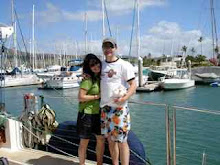Both of our jobs are actually pretty interesting. Matt works as an Assistant Attorney General for Yap State. His office is pretty small – the AG is in charge of two AAGs (Matt and one other American attorney), and two Yapese trial counselors. (The Colorado Office of the Attorney General, by way of comparison, has something on the order of 350 attorneys.) Matt works mainly on civil matters, leaving the criminal prosecutions to the others in the office. People do illegal things no matter where you are in the world, and Yap is no exception. Illegal fishing cases are common – here’s a picture of a Taiwanese longliner that was recently seized in a case that Matt is currently handling.

Dress at work is casual and, KC might argue, requires very little fashion sense.

In March, just 3 weeks after we arrived, Matt took the Federated States of Micronesia bar exam (for anyone who is counting – and that includes us – that’s now three bar exams: Colorado, Wyoming, FSM). Last week he was sworn in to the bars of both Yap State and the FSM. And just in time, too, since he had to appear in a hearing a scant two hours after the ceremony was over.

KC is a clerk for the Yap Division of the FSM federal court system. She works here.

The pace for KC is definitely different than her practice was in the United States, but she is enjoying her work. Working as a law clerk gives an attorney a chance to peek behind the curtain to see how decisions are made, and provides a perspective that can be extraordinarily helpful when one goes back to the real world.
Next month KC is headed to Chuuk, one of other states in the FSM, to assist her judge with two appeals that are being heard there. Matt won’t be able to accompany her on the trip. If he can avoid starving while she’s away, he’s looking forward to the fabulous pictures that she’s planning on bringing back.




























